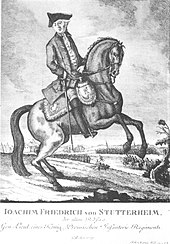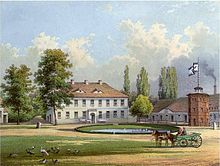Joachim Friedrich von Stutterheim
Joachim Friedrich von Stutterheim ("Alt-Stutterheim"), (born November 2, 1715 in Sellendorf , Niederlausitz ; † August 26, 1783 in Königsberg in Prussia ) was a royal Prussian lieutenant general .
origin
His parents were Joachim Friedrich von Stutterheim (1683–1745) and Johanne Eleonore von Hacke (1687–1737). His father was a royal Polish and electoral Saxon captain lieutenant and landowner. His brother Otto Ludwig (1718–1780) also became a Prussian lieutenant general.
Life
Through a chance encounter with King Friedrich Wilhelm I of Prussia, whom he liked, he was accepted into the Berlin Cadet Corps in 1729 with the consent of his father . From this he joined the "Regiment Kröcher on foot" (1806: No. 18) as a flag junior in 1732 . There he was ensign in 1735 and second lieutenant in 1739 .
As such he went to the 1st Silesian War and even before the battle of Mollwitz stood out in a command that the king awarded him the order Pour le Mérite and a canon position at Cammin and a company with the “Regiment La Motte zur Foot ” (1806: No. 17). Stutterheim then fought in the fights at Chotusitz , Hohenfriedberg and Thrush . He was wounded with thrush.
Promoted to major in 1747 , he did so again at Lobositz that the king awarded him an extraordinary pension of 500 thalers a year. In May 1757 he received the command of the regiment as a lieutenant colonel , fighting in that year, in which he also became a colonel , near Prague , Kolín and Breslau , the next near Hochkirch . On January 1, 1759, he was promoted to major general and received his own infantry regiment, the former "Kannacher Foot Regiment" (1806: No. 30).
He now came to Prince Heinrich's army ; On September 13, 1759, he reported from Görlitz that Stutterheim zu Friedland had burned an enemy magazine and made 700 prisoners.
In 1760 he took part in the battles near Liegnitz and von Torgau . He was badly wounded near Torgau. In 1761 he was back in the army of Prince Heinrich, who sent him with 1,600 men to protect the mark against an invasion by the Swedes. He also took part in the last campaign, in 1762, under Prince Heinrich; at the battle of Freiberg delivered on October 29th , he commanded the left wing of the attacking line. As thanks for his share in the victory, he received a canonical at the St. Nicolaistift in Magdeburg .
When the peace was concluded, the King sent Stutterheim to Königsberg as inspector of the East Prussian infantry. In 1768, after he had become Lieutenant General on August 24, 1767 , he received the Order of the Black Eagle and another regiment, the former "Regiment Kanitz on foot" (1806: No. 2). He was also appointed governor of Koenigsberg, Pillau and Memel .
In the War of the Bavarian Succession he was at the head of a separate corps in the king's army in Upper Silesia, and on August 16, 1778, he took Troppau .
The Great King wrote "Alt-Stutterheim" shortly before his death:
" You can be assured that your fate cannot be entrusted to any better hand than mine, your services will remain unforgettable in my heart ."
monument
Stutterheim's name is attached to the monument of Frederick the Great on Unter den Linden in Berlin.
family
He was married to Sophie Therese von Lettow (* 1719 or 1720; † September 6, 1807 in Stettenbruch). His children include:
- Ludwig August (1751–1826), Prussian general ∞ Luise Charlotte Albertine Juliane von Ingersleben (1765–1869)
- Otto Georg (* 1752; † October 1, 1817) ∞ Wilhelmine Friederike von Anhalt (* December 16, 1770; † December 31, 1802, Pisa, Italy) (divorced in 1797, she was the daughter of Heinrich Wilhelm von Anhalt )
Individual evidence
literature
- Bernhard von Poten : Stutterheim, Joachim Friedrich von . In: Allgemeine Deutsche Biographie (ADB). Volume 37, Duncker & Humblot, Leipzig 1894, p. 74 f.
- Eckart von Stutterheim and Kurt von Stutterheim: The gentlemen and barons of Stutterheim / Alt-Stutterheim . Verlag Degener & Co., Neustadt an der Aisch 1965, pp. 143–144, illustration after p. 144, and p. 219–224, illustration after p. 220
- Kurt von Priesdorff (ed.): Soldatisches Führertum . Volume 1, Hanseatische Verlagsanstalt, Hamburg 1937, DNB 367632764 , p. 490 ff., No. 501 (with picture).
- Anton Balthasar König : Joachim Friedrich von Stutterheim . In: Biographical lexicon of all heroes and military people . tape IV . Arnold Wever, Berlin 1791, p. 428 ( Joachim Friedrich von Stutterheim the elder in the Google book search).
| personal data | |
|---|---|
| SURNAME | Stutterheim, Joachim Friedrich von |
| ALTERNATIVE NAMES | Alt-Stutterheim, Joachim Friedrich von |
| BRIEF DESCRIPTION | Prussian lieutenant general |
| DATE OF BIRTH | November 2, 1715 |
| PLACE OF BIRTH | Sellendorf , Lower Lusatia |
| DATE OF DEATH | August 26, 1783 |
| Place of death | Königsberg (Prussia) |


